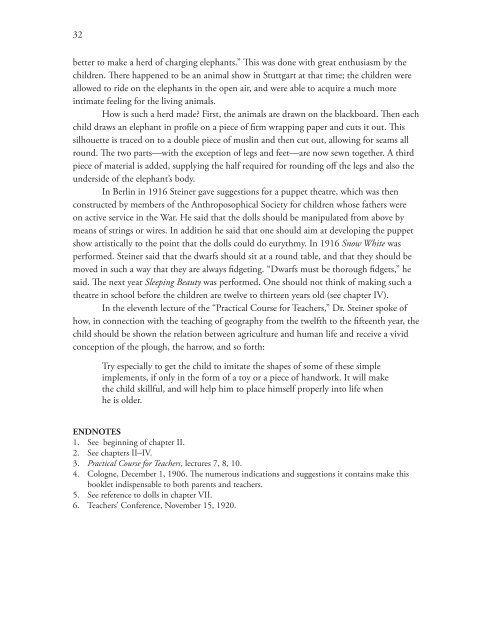Handwork and Handicrafts - Waldorf Research Institute
Handwork and Handicrafts - Waldorf Research Institute
Handwork and Handicrafts - Waldorf Research Institute
Create successful ePaper yourself
Turn your PDF publications into a flip-book with our unique Google optimized e-Paper software.
32<br />
better to make a herd of charging elephants.” This was done with great enthusiasm by the<br />
children. There happened to be an animal show in Stuttgart at that time; the children were<br />
allowed to ride on the elephants in the open air, <strong>and</strong> were able to acquire a much more<br />
intimate feeling for the living animals.<br />
How is such a herd made? First, the animals are drawn on the blackboard. Then each<br />
child draws an elephant in profile on a piece of firm wrapping paper <strong>and</strong> cuts it out. This<br />
silhouette is traced on to a double piece of muslin <strong>and</strong> then cut out, allowing for seams all<br />
round. The two parts—with the exception of legs <strong>and</strong> feet—are now sewn together. A third<br />
piece of material is added, supplying the half required for rounding off the legs <strong>and</strong> also the<br />
underside of the elephant’s body.<br />
In Berlin in 1916 Steiner gave suggestions for a puppet theatre, which was then<br />
constructed by members of the Anthroposophical Society for children whose fathers were<br />
on active service in the War. He said that the dolls should be manipulated from above by<br />
means of strings or wires. In addition he said that one should aim at developing the puppet<br />
show artistically to the point that the dolls could do eurythmy. In 1916 Snow White was<br />
performed. Steiner said that the dwarfs should sit at a round table, <strong>and</strong> that they should be<br />
moved in such a way that they are always fidgeting. “Dwarfs must be thorough fidgets,” he<br />
said. The next year Sleeping Beauty was performed. One should not think of making such a<br />
theatre in school before the children are twelve to thirteen years old (see chapter IV).<br />
In the eleventh lecture of the “Practical Course for Teachers,” Dr. Steiner spoke of<br />
how, in connection with the teaching of geography from the twelfth to the fifteenth year, the<br />
child should be shown the relation between agriculture <strong>and</strong> human life <strong>and</strong> receive a vivid<br />
conception of the plough, the harrow, <strong>and</strong> so forth:<br />
Try especially to get the child to imitate the shapes of some of these simple<br />
implements, if only in the form of a toy or a piece of h<strong>and</strong>work. It will make<br />
the child skillful, <strong>and</strong> will help him to place himself properly into life when<br />
he is older.<br />
ENDNOTES<br />
1. See beginning of chapter II.<br />
2. See chapters II–IV.<br />
3. Practical Course for Teachers, lectures 7, 8, 10.<br />
4. Cologne, December 1, 1906. The numerous indications <strong>and</strong> suggestions it contains make this<br />
booklet indispensable to both parents <strong>and</strong> teachers.<br />
5. See reference to dolls in chapter VII.<br />
6. Teachers’ Conference, November 15, 1920.

















